Down-regulation of beta-catenin by activated p53
- PMID: 11564862
- PMCID: PMC99855
- DOI: 10.1128/MCB.21.20.6768-6781.2001
Down-regulation of beta-catenin by activated p53
Abstract
beta-Catenin is a cytoplasmic protein that participates in the assembly of cell-cell adherens junctions by binding cadherins to the actin cytoskeleton. In addition, it is a key component of the Wnt signaling pathway. Activation of this pathway triggers the accumulation of beta-catenin in the nucleus, where it activates the transcription of target genes. Abnormal accumulation of beta-catenin is characteristic of various types of cancer and is caused by mutations either in the adenomatous polyposis coli protein, which regulates beta-catenin degradation, or in the beta-catenin molecule itself. Aberrant accumulation of beta-catenin in tumors is often associated with mutational inactivation of the p53 tumor suppressor. Here we show that overexpression of wild-type p53, by either transfection or DNA damage, down-regulates beta-catenin in human and mouse cells. This effect was not obtained with transcriptionally inactive p53, including a common tumor-associated p53 mutant. The reduction in beta-catenin level was accompanied by inhibition of its transactivation potential. The inhibitory effect of p53 on beta-catenin is apparently mediated by the ubiquitin-proteasome system and requires an active glycogen synthase kinase 3beta (GSK3beta). Mutations in the N terminus of beta-catenin which compromise its degradation by the proteasomes, overexpression of dominant-negative DeltaF-beta-TrCP, or inhibition of GSKbeta activity all rendered beta-catenin resistant to down-regulation by p53. These findings support the notion that there will be a selective pressure for the loss of wild-type p53 expression in cancers that are driven by excessive accumulation of beta-catenin.
Figures

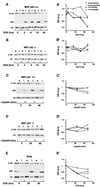
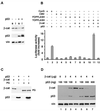
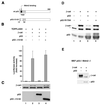
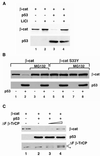
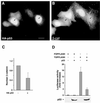

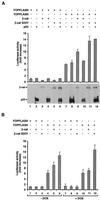
Similar articles
-
beta-catenin is a target for the ubiquitin-proteasome pathway.EMBO J. 1997 Jul 1;16(13):3797-804. doi: 10.1093/emboj/16.13.3797. EMBO J. 1997. PMID: 9233789 Free PMC article.
-
Regulation of beta-catenin signaling by the B56 subunit of protein phosphatase 2A.Science. 1999 Mar 26;283(5410):2089-91. doi: 10.1126/science.283.5410.2089. Science. 1999. PMID: 10092233
-
The B cell antigen receptor regulates the transcriptional activator beta-catenin via protein kinase C-mediated inhibition of glycogen synthase kinase-3.J Immunol. 2002 Jul 15;169(2):758-69. doi: 10.4049/jimmunol.169.2.758. J Immunol. 2002. PMID: 12097378
-
Melanoma cell lines contain a proteasome-sensitive, nuclear cytoskeleton-associated pool of beta-catenin.Ann N Y Acad Sci. 1999;886:208-11. doi: 10.1111/j.1749-6632.1999.tb09418.x. Ann N Y Acad Sci. 1999. PMID: 10667221 Review. No abstract available.
-
[Ubiquitin-dependent proteolysis by SCF complex].Seikagaku. 2000 Feb;72(2):113-7. Seikagaku. 2000. PMID: 10737103 Review. Japanese. No abstract available.
Cited by
-
Beta-catenin simultaneously induces activation of the p53-p21WAF1 pathway and overexpression of cyclin D1 during squamous differentiation of endometrial carcinoma cells.Am J Pathol. 2004 May;164(5):1739-49. doi: 10.1016/s0002-9440(10)63732-7. Am J Pathol. 2004. PMID: 15111320 Free PMC article.
-
Beta-catenin is a mediator of the response of fibroblasts to irradiation.Am J Pathol. 2009 Jan;174(1):248-55. doi: 10.2353/ajpath.2009.080576. Epub 2008 Nov 26. Am J Pathol. 2009. PMID: 19036807 Free PMC article.
-
Bioinformatic analyses identifies novel protein-coding pharmacogenomic markers associated with paclitaxel sensitivity in NCI60 cancer cell lines.BMC Med Genomics. 2011 Feb 11;4:18. doi: 10.1186/1755-8794-4-18. BMC Med Genomics. 2011. PMID: 21314952 Free PMC article.
-
Critical roles of p53 in epithelial-mesenchymal transition and metastasis of hepatocellular carcinoma cells.PLoS One. 2013 Sep 2;8(9):e72846. doi: 10.1371/journal.pone.0072846. eCollection 2013. PLoS One. 2013. PMID: 24023784 Free PMC article.
-
WNT Signaling in Melanoma.Int J Mol Sci. 2020 Jul 9;21(14):4852. doi: 10.3390/ijms21144852. Int J Mol Sci. 2020. PMID: 32659938 Free PMC article. Review.
References
-
- Abarzua P, LoSardo J E, Gubler M L, Neri A. Microinjection of monoclonal antibody PAb421 into human SW480 colorectal carcinoma cells restores the transcription activation function to mutant p53. Cancer Res. 1995;55:3490–3494. - PubMed
-
- Adams C, Nelson W. Cytomechanics of cadherin-mediated cell-cell adhesion. Curr Opin Cell Biol. 1998;10:572–577. - PubMed
-
- Albrechtsen N, Dornreiter I, Grosse F, Kim E, Wiesmuller L, Deppert W. Maintenance of genomic integrity by p53: complementary roles for activated and non-activated p53. Oncogene. 1999;18:7706–7717. - PubMed
-
- Ashcroft M, Vousden K H. Regulation of p53 stability. Oncogene. 1999;18:7637–7643. - PubMed
Publication types
MeSH terms
Substances
Grants and funding
LinkOut - more resources
Full Text Sources
Other Literature Sources
Research Materials
Miscellaneous
